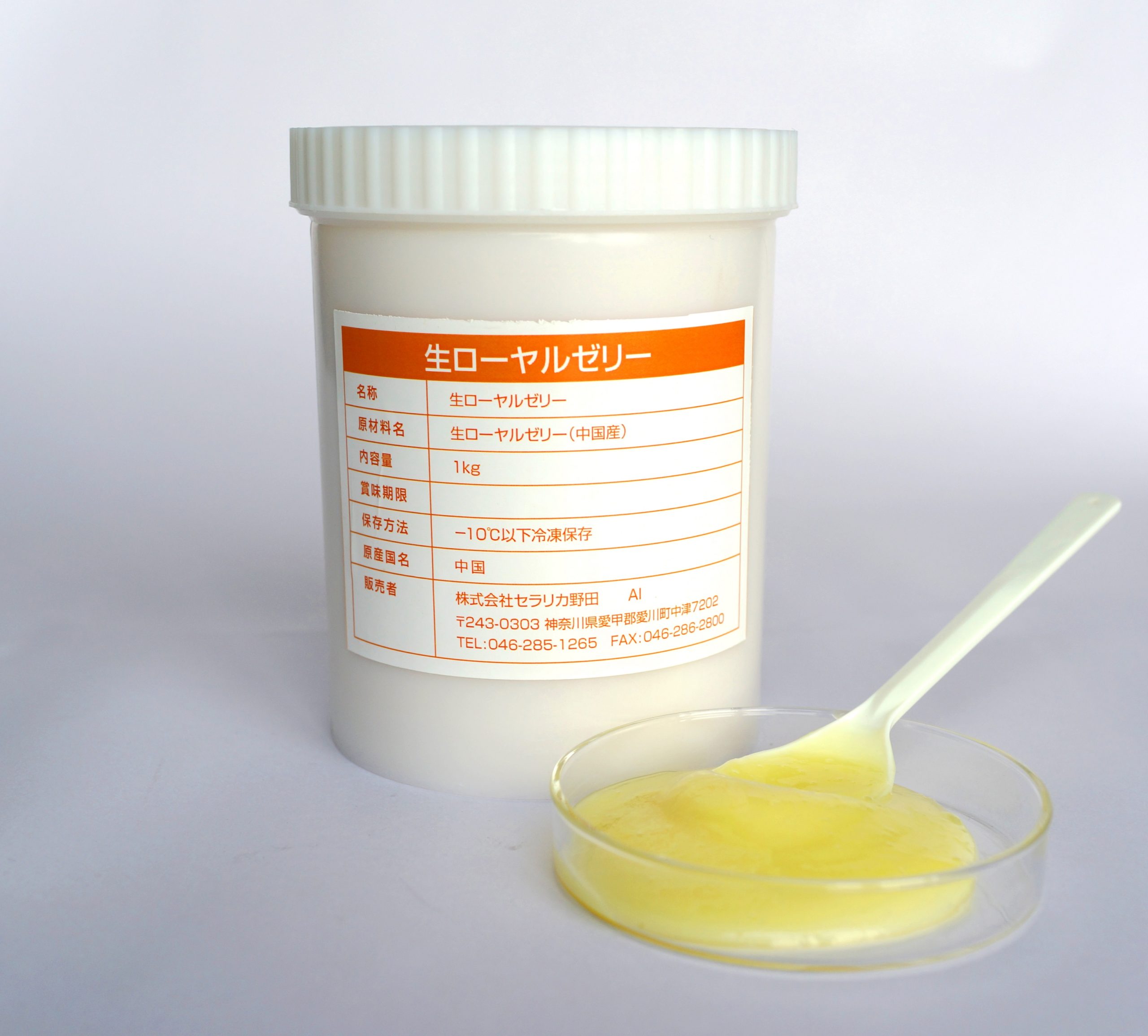Click here to purchase the product
Key points of raw royal jelly
- Rich in vitamins A, B1, B2, B6, E and minerals, and also contains essential amino acids.
- Developed under the guidance of the Bee Research Institute of the Chinese Academy of Agricultural Sciences, China's highest national institution.
- Delivered frozen under strict freshness control.
What is raw royal jelly?
Raw royal jelly is a valuable emulsion created by adding fatty acids such as decenoic acid from the mandibular glands to a protein-rich milky liquid secreted by young worker bees from the glands under their jaws (hypopharyngeal glands). is. Although it contains a lot of carbohydrates, it is characterized by a low sweetness and a sharp, sour taste. This is produced exclusively for the queen bee by young worker bees who are 6 to 12 days old, and is a special food that only the queen bee can eat, making it a highly nutritious food. When a queen bee is born, it is no different from other bees, but it grows up in a special chamber * , feeding only on royal jelly, and its body size is 1.5 to 3 times that of the worker bees, and its lifespan is 30 to 40 times longer. Masu.
*Special room: A room for raising queen bee larvae. The eggs are laid in a special room and are treated as queens from the moment they hatch.

Effects of raw royal jelly
Royal jelly contains amino acids, proteins, minerals, vitamins, lipids, carbohydrates, and other trace amounts of active ingredients. These unique nutrients are necessary and essential for better health. It can also be used to treat indeterminate complaints caused by stress, restore physical strength after surgery, and activate metabolism.
Differences from commercially available royal jelly
In addition to fresh royal jelly, there are dried royal jelly and prepared royal jelly.
Dried royal jelly is made by evaporating the water from raw royal jelly using a freeze-drying process and turning it into a powder. Although it can be stored at room temperature, trace components will be reduced during the drying process.
Prepared royal jelly contains more than 1/6 of royal jelly as raw materials, and because many sub-raw materials and additives are added to fresh royal jelly or dried royal jelly, the concentration of royal jelly, the active ingredient, is low. The effect is also much weaker.
Raw royal jelly is the same state that the queen bee ingests and is immediately packed into a container, so the original flavor and nutrients of royal jelly can be preserved. It is also said to be a rare form of royal jelly because it is difficult to control its freshness.
Difference between royal jelly and honey
Royal jelly is a valuable cream-like substance that young worker bees synthesize in their bodies from pollen and honey and secrete from their pharyngeal glands.
Honey is produced by bees that collect nectar from flowers, decompose the sucrose, a component of the nectar, into glucose and fructose in the bees' bodies using salivary enzymes, store the resulting products in their hives, and evaporate the water by flapping their wings. It is concentrated until the sugar content is 80%.
Approximately 80% of honey is sugar, and most of the remaining 20% is water. It contains only a few percent of vitamins, minerals, carbohydrates, and amino acids. Royal jelly contains only about 7% sugar. Approximately 85% is a valuable active ingredient. It is rich in rare nutrients such as vitamins, minerals, carbohydrates, and amino acids.


Nutritional value of honey and royal jelly

Delicious ways to eat raw royal jelly
- Mix 1 spoonful with equal amounts of honey and enjoy as is. The unique irritation and smell are alleviated, making it delicious.
- Spread it on toast or dissolve it directly in lactic acid drinks such as Calpis, yogurt, and milk to soften the unique taste and enjoy it.
- When mixed with citrus juice, the sourness of the citrus will soften the sourness of royal jelly.
- It can also be served as a sorbet. It is refreshing and can be eaten as is, but it retains a unique sour taste, so if you don't like the sour taste of royal jelly, we recommend mixing it with citrus sorbet.
Precautions when eating
- You need to be careful when eating on an empty stomach, as it will put a strain on your stomach. Royal jelly, which is rich in nutrients, may be a burden on the stomach for some people.
- For about 30 minutes before and after meals, refrain from drinking tea, coffee, black tea, and other beverages that contain a lot of tannins, and instead drink water or hot water
. The iron and tannins contained in royal jelly may bind together, reducing the rate of nutrient absorption. *Tannins: A general term for polyphenols found in plant leaves, and the astringent component of green tea. Catechin is also a type of tannin. - Royal jelly is sensitive to heat, and if you drink it with hot drinks, the active ingredients will be easily destroyed. You should refrain from eating hot foods for 30 minutes before and after meals.
- When eating, please use a plastic spoon instead of metal.
- It reacts with metals and oxidizes.
How to store raw royal jelly
Please store it in the freezer.
Also, when storing, transfer 100 to 150g (amount to be eaten) from the container to a highly airtight pack, divide into small portions, freeze again, and take out only one pack from the refrigerator to keep it fresh. The quality is maintained.
Although raw royal jelly contains antibacterial substances, it is a nutritious food and should be consumed as soon as possible.




